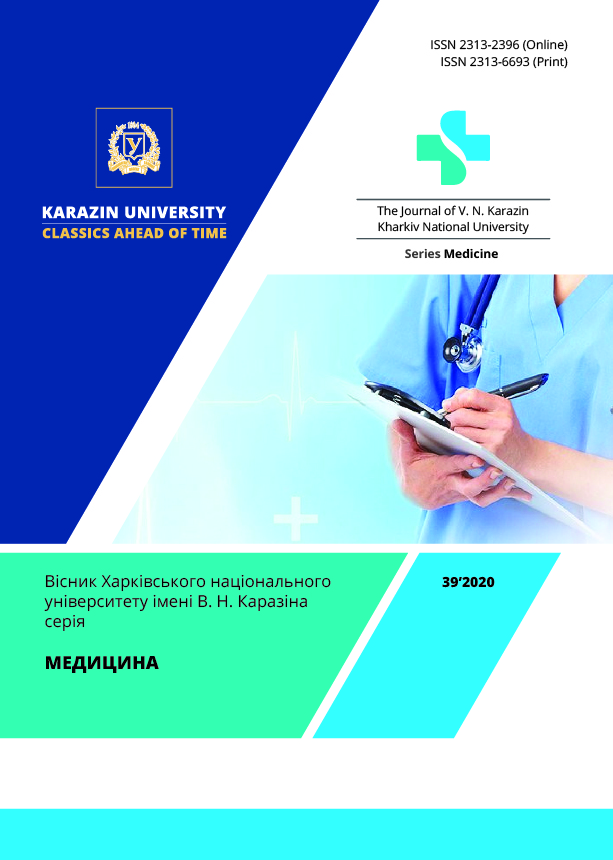Puncture methods of treatment of patients with fluid formations of the pancreas and liver
Abstract
Summary. Diagnosis and treatment fluid formations of the liver and pancreas non-parasitic genesis remains a controversial issue, despite current advances in minimally invasive surgery. The aim of the study is to improve the results of surgical treatment of patients with fluid formations of the liver and pancreas non-parasitic genesis through the integrated use of mini-invasive methods of diagnosis and surgical treatment. Patients were carried out clinical, instrumental, laboratory methods of examination, in the course of which liquid formations were revealed. With the help of ultrasound of the apparatus the liquid structure was elucidated, then dopplerography determined the non-vascular zone for passing the puncture needle. For punctures we used special nozzles on the ultrasonic sensor. The puncture was performed under local anesthesia. Chiba-type needles were used for the puncture, and Pig tail catheters from 6 to 9 F were used for drainage. The timing of the puncture was determined individually, taking into account clinical and sonographic signs, with the average time of drainage of pancreatic cysts being 24 ± 4,3 days, and drainage of liver cysts – 32 ± 1,6 days. Indications for puncture under the control of sonography and laparoscopic treatment were determined. Puncture-draining interventions were performed in 53 patients with non-parasitic liver cysts, of which 30 patients were drained under ultrasound control, and 23 patients underwent video laparoscopic drainage. Also punctuation-drainage interventions were performed in 72 patients with pseudo-pancreatic cysts, of which ultrasonic drainage was performed in 48 patients, 24 patients had video laparoscopic drainage. In the case of puncture treatment of liver cysts and pancreas, narcotic analgesics were not used for pain relief. The postoperative period was more favorable in patients where percutaneous puncture interventions were used. Immediately after percutaneous interventions under ultrasound control and from the second day after videolaparoscopic operations, patients returned to their usual diet and volume of physical activity. Thus, comparing different methods of surgical treatment of non-parasitic fluid formations of the liver and pancreas it was established that application of puncture-draining methods allowed to improve significantly medical and social indices of this group of patients.
Downloads
References
Marino K. A., Hendrick L. E., Behrman S. W. Surgical management of complicated pancreatic pseudocysts after acute pancreatitis. Am J. Surg. 2016 Jan; 211(1): 109–14. American. doi: 10.1016/j.amjsurg.2015.07.020.
Shevchenkо B. F., Babiy A. M. [Results of surgical treatment of chronic pancreatitis and cysts of the pancreas in view of their morphological condition during surgery] Ukrayins`ky`j zhurnal xirurgiyi. 2017; 1 (32):80–90 Ukrainian. DOI: 10.22141/1997-2938.1.32.2017.98496
Khar’kov DP, Fedoruk AM, Savchenko AV, Rummo OO. [Pancreatic Pseudocysts: the Effectiveness of Percutaneous Minimally Invasive Technology of Pancreatoсystogastrostomy Formation on the Stent]. Annals of HPB Surgery. 2015; 20(3):117–123. Russian. doi.org/10.16931/10.16931/1995-5464.20153117-123
Yareshko V. G., Mikheiev I. O., Zhyvytsia S. G., Kryvoruchko I. V. [Diagnosis and differential approach to the choice of treatment of pseudocysts of the pancreas]. Medichni perspektivi. 2017; 18(XXIII/4ч.1):124–31.Ukrainian.doi.org/10.26641/2307-0404.2018.4(part1).145718
Zerem E, Hauser G, Loga-Zec S, Kunosić S, Jovanović P , Crnkić D. Minimally invasive treatment of pancreatic pseudocysts. World J. Gastroenter. 2015 Jun; 21: 6850-60. Bosnia Herzegovina. doi: 10.3748/wjg.v21.i22.6850
Prokopchik N. I., Tsyrkunov V. M. [Clinical morphology of liver: benign tumors]. Journal of the Grodno State Medical University. 2018; 16(2) 2: 202–9. Belarusian. doi: 10.25298/2221-8785-2018-16-2-202-209
Moshkivs’kyĭ H Iu. [Methodological and Tactico-Technical Basics of Transcutaneous Echocontrolled Interventions]. Klin Khir. 2012 Sep; (9):25–8. Ukrainian. PMID: 23285648
Carlos M, Sebastian U. Infected Hepatic Echinococcosis: Results of Surgical Treatment of a Consecutive Series of Patients. Surg. Infect. 2015 Oct; 16(5): 553–7. American. doi: 10.1089/sur.2014.054
The Journal of V. N. Karazin Kharkiv National University, series Medicine has following copyright terms:
- Authors retain copyright and grant the journal right of first publication with the work simultaneously licensed under a Creative Commons Attribution License that allows others to share the work with an acknowledgement of the work’s authorship and initial publication in this journal.
- Authors are able to enter into separate, additional contractual arrangements for the non-exclusive distribution of the journal’s published version of the work, with an acknowledgement of its initial publication in this journal.
- Authors are permitted and encouraged to post their work online prior to and during the submission process, as it can lead to productive exchanges, as well as earlier and greater citation of published work.




